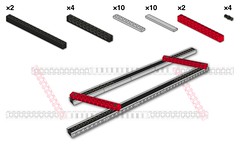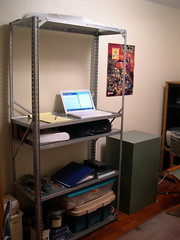Workspaces
Amar Sagoo (author of Namely) finds that a tabletop whiteboard is a useful tool for planning and discussion:
We’ve found ourselves using it virtually every day, illustrating explanations, walking through calculations and brainstorming design ideas. Visitors will intuitively pick up a pen and start using the whiteboard when explaining things. It somehow seems to invite people to use it more than most whiteboards. However, it’s not only a collaborative tool: it also makes a great scratch-pad when you’re brainstorming on your own. To ensure that it stays useful, we make an effort to keep the board clean; nothing tends to stay on there for longer than a day or so.
I’ve got a large roll of packing paper which I use for a similar purpose at my desk. It’s great to be able to jot down a note or a doodle without pausing to search for paper or an appropriate notebook. As the sheet fills up, I pull it down to reveal a clean area. I’ve yet to devise an effective spool, but the scroll nevertheless contains an interesting record of spontaneous notes and drawings.
Now that I’m studying mechanical drawing, I’ve developed an interest in drafting equipment and techniques. Perhaps in the future my desk will receive further augmentation. In the meantime, a fine set of parallel rules can be made from surplus LEGO:
Lastly, I’ve fiddled with some of my shelving to make a nice standing work area for my laptop:
It may not be the best arrangement for long sessions, but I’ve found it surprisingly practical for many tasks. I think that standing up helps me to stay focused. When my mind wanders (as it is wont to do) it is easier to step back and tend to other things than when seated.
The kitchen table is a good place to get things done, too.
Posted on Tuesday, January 29th, 2008.


